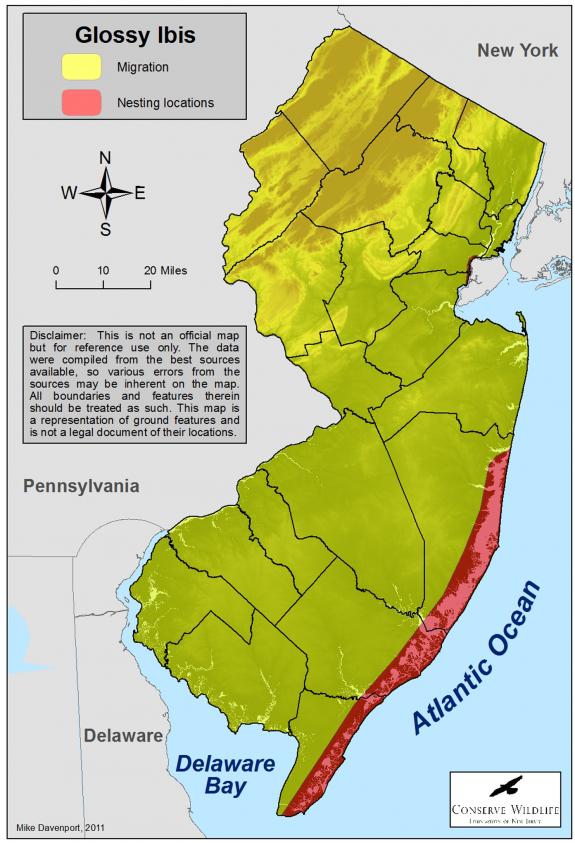Plegadis falcinellus
Type: bird
Status: special concern
Species Guide
Glossy ibis
Plegadis falcinellus
Species Type: bird
Conservation Status: special concern
IDENTIFICATION
The glossy ibis is a medium-sized wading bird with a long neck, long legs, and a long, slender decurved bill. They grow to a length of 25 inches. Its plumage color is a deep glossy chestnut glossed with purple and green during the breeding season, but it may appear dark brown at a distance. Males and females look similar. In flight, they hold their neck extended straight and fly with faster wingbeats than herons’. When flying in groups, they will often fly in a straight line.

Distribution & Habitat
This species is not native to North America. However, it was not introduced by humans like most non-native species have been. Like the cattle egret (Bubulcus ibis), it colonized the Western Hemisphere by flying across the Atlantic Ocean, probably from Africa.
The glossy ibis is a year-round resident in northern South America, the West Indies, the Yucatan peninsula of Mexico, and along the U.S. coastline from Louisiana to Florida and as far north as North Carolina. During the breeding season, they extend their range northward as far as Maine. The glossy ibis primarily occurs within New Jersey only during the breeding season and along the coast.
Their preferred habitat is marsh, swamps, edges of ponds or lakes, estuaries, bays, and forest bordering water bodies. They will nest either on the ground or in small trees or bushes by fresh or salt water, usually no higher than 10 feet above the ground.
Diet
The glossy ibis will forage in and alongside water bodies. They feed on crayfish, insects, small reptiles, and aquatic invertebrates. They feed by wading into or alongside water and probing into the mud or water with their long beak.
Life Cycle
The breeding season of the glossy ibis begins in April or May and ends by late August. They nest in colonies which are often quite large and may be occupied by heron and egret species as well.
Both the male and female build the nest. Two to four blue or greenish-blue eggs are laid and then incubated by both adults for about 21 days. The nestlings are semi-altrical and are cared for by both parents. The young will leave the nest for nearby branches at about 2 weeks of age.
Current Threats, Status, and Conservation
The greatest threat to the glossy ibis is habitat loss and degradation together with disturbance of nesting colonies. Oil spills and pesticide contamination are also potential threats to the habitats preferred by the ibis. This species is listed as a Species of Special Concern in New Jersey (not yet endangered or threatened but possibly on its way).
Like many species in New Jersey, protecting glossy ibises is closely tied with protecting their wetland habitats. Strong environmental laws to protect wetlands from disturbance and development help to protect wetlands and the ibis.
We still have much to learn about the biology and population status of glossy ibises in New Jersey. Research needs to be completed to find additional breeding sites, check existing nesting areas, and determine whether the population might be decreasing or increasing.
References
Text written by Michael J. Davenport in 2011.
Scientific Classification
- Kingdom: Animalia
- Phylum: Chordata
- Class: Aves
- Order: Ciconiformes
- Family: Threskionithidae
- Genus: Plegadis
- Species: P. falcinellus